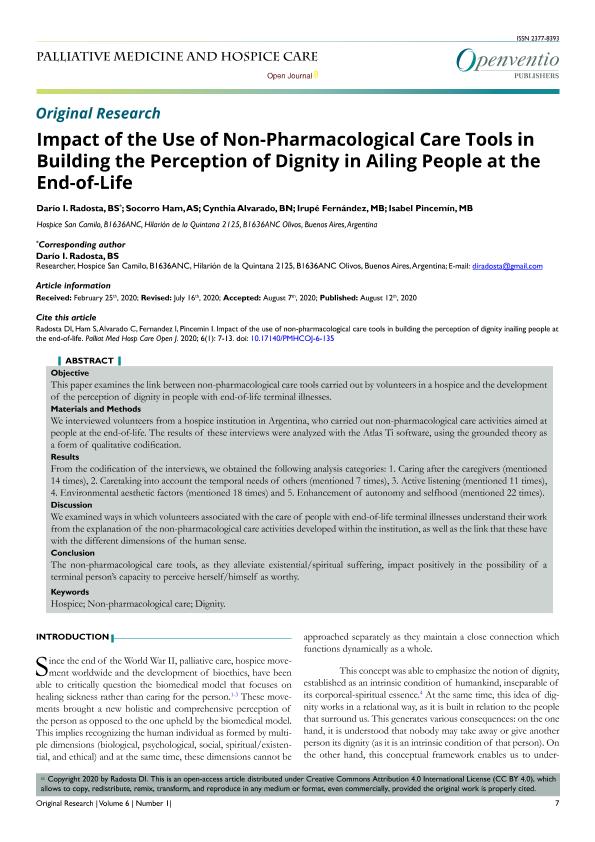Mostrar el registro sencillo del ítem
dc.contributor.author
Radosta Rosas, Darío Iván

dc.contributor.author
Ham, Socorro
dc.contributor.author
Alvarado, Cynthia
dc.contributor.author
Fernández, Irupé
dc.contributor.author
Pincemín, Isabel
dc.date.available
2022-09-29T17:51:37Z
dc.date.issued
2020-08-12
dc.identifier.citation
Radosta Rosas, Darío Iván; Ham, Socorro; Alvarado, Cynthia; Fernández, Irupé; Pincemín, Isabel; Impact of the Use of Non-Pharmacological Care Tools in Building the Perception of Dignity in Ailing People at the End-of-Life; Openventio publishers; Palliative medicine and hospice care; 6; 1; 12-8-2020; 7-13
dc.identifier.issn
2377-8393
dc.identifier.uri
http://hdl.handle.net/11336/171122
dc.description.abstract
Objective This paper examines the link between non-pharmacological care tools carried out by volunteers in a hospice and the development of the perception of dignity in people with end-of-life terminal illnesses. Materials and Methods We interviewed volunteers from a hospice institution in Argentina, who carried out non-pharmacological care activities aimed at people at the end-of-life. The results of these interviews were analyzed with the Atlas Ti software, using the grounded theory as a form of qualitative codification. Results From the codification of the interviews, we obtained the following analysis categories: 1. Caring after the caregivers (mentioned 14 times), 2. Caretaking into account the temporal needs of others (mentioned 7 times), 3. Active listening (mentioned 11 times), 4. Environmental aesthetic factors (mentioned 18 times) and 5. Enhancement of autonomy and selfhood (mentioned 22 times). Discussion We examined ways in which volunteers associated with the care of people with end-of-life terminal illnesses understand their work from the explanation of the non-pharmacological care activities developed within the institution, as well as the link that these have with the different dimensions of the human sense. Conclusion The non-pharmacological care tools, as they alleviate existential/spiritual suffering, impact positively in the possibility of a terminal person’s capacity to perceive herself/himself as worthy.
dc.format
application/pdf
dc.language.iso
eng
dc.publisher
Openventio publishers
dc.rights
info:eu-repo/semantics/openAccess
dc.rights.uri
https://creativecommons.org/licenses/by/2.5/ar/
dc.subject
Hospice
dc.subject
Non-pharmacological care
dc.subject
Dignity
dc.subject.classification
Ciencias Biomédicas Sociales

dc.subject.classification
Ciencias de la Salud

dc.subject.classification
CIENCIAS MÉDICAS Y DE LA SALUD

dc.title
Impact of the Use of Non-Pharmacological Care Tools in Building the Perception of Dignity in Ailing People at the End-of-Life
dc.type
info:eu-repo/semantics/article
dc.type
info:ar-repo/semantics/artículo
dc.type
info:eu-repo/semantics/publishedVersion
dc.date.updated
2022-09-22T15:11:52Z
dc.identifier.eissn
2377-8393
dc.journal.volume
6
dc.journal.number
1
dc.journal.pagination
7-13
dc.journal.pais
Estados Unidos

dc.journal.ciudad
Willow Oaks
dc.description.fil
Fil: Radosta Rosas, Darío Iván. Hospice San Camilo; Argentina. Universidad Nacional de San Martín. Instituto de Altos Estudios Sociales; Argentina. Consejo Nacional de Investigaciones Científicas y Técnicas; Argentina
dc.description.fil
Fil: Ham, Socorro. Hospice San Camilo; Argentina
dc.description.fil
Fil: Alvarado, Cynthia. Hospice San Camilo; Argentina
dc.description.fil
Fil: Fernández, Irupé. Asociación Argentina de Medicina y Cuidados Paliativos; Argentina
dc.description.fil
Fil: Pincemín, Isabel. Hospice San Camilo; Argentina
dc.journal.title
Palliative medicine and hospice care
dc.relation.alternativeid
info:eu-repo/semantics/altIdentifier/url/https://openventio.org/wp-content/uploads/Impact-of-the-Use-of-Non-Pharmacological-Care-Tools-in-Building-the-Perception-of-Dignity-Inailing-People-at-the-End-of-Life-PMHCOJ-6-135-3.pdf
dc.relation.alternativeid
info:eu-repo/semantics/altIdentifier/doi/http://dx.doi.org/10.17140/PMHCOJ-6-135
Archivos asociados
